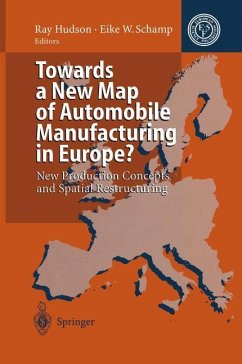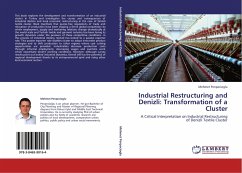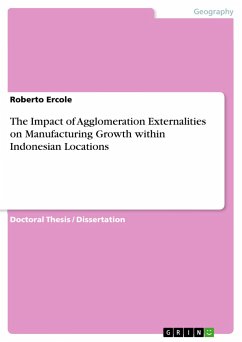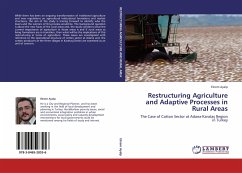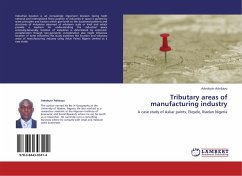Towards a New Map of Automobile Manufacturing in Europe?
New Production Concepts and Spatial Restructuring
Mitarbeit: Amin, A.; Conti, S.; Dicken, P.; Enriette, A.; Ferrao, J.; Herausgegeben von Hudson, Ray; Schamp, Eike W.
Towards a New Map of Automobile Manufacturing in Europe?
New Production Concepts and Spatial Restructuring
Mitarbeit: Amin, A.; Conti, S.; Dicken, P.; Enriette, A.; Ferrao, J.; Herausgegeben von Hudson, Ray; Schamp, Eike W.
- Broschiertes Buch
- Merkliste
- Auf die Merkliste
- Bewerten Bewerten
- Teilen
- Produkt teilen
- Produkterinnerung
- Produkterinnerung
This book is the product of four years of collaborative work within the framework of the European Science Foundation's Regional and Urban Restructuring in Europe (RURE) programme. With one exception, all of the chapters have been prepared by participants in RURE - the exception being that commissioned from Conti and Enrietti on Fiat and Italy to provide a fuller coverage of changes in the main automobile producing companies and countries of Europe. A - perhaps the - central theme around which the RURE programme was conceived is that the restructuring of the production system lies at the heart…mehr
Andere Kunden interessierten sich auch für
![Industrial Restructuring and Denizli: Transformation of a Cluster Industrial Restructuring and Denizli: Transformation of a Cluster]() Mehmet PenpeciogluIndustrial Restructuring and Denizli: Transformation of a Cluster44,99 €
Mehmet PenpeciogluIndustrial Restructuring and Denizli: Transformation of a Cluster44,99 €![The Impact of Agglomeration Externalities on Manufacturing Growth within Indonesian Locations The Impact of Agglomeration Externalities on Manufacturing Growth within Indonesian Locations]() Roberto ErcoleThe Impact of Agglomeration Externalities on Manufacturing Growth within Indonesian Locations52,95 €
Roberto ErcoleThe Impact of Agglomeration Externalities on Manufacturing Growth within Indonesian Locations52,95 €![Restructuring Agriculture and Adaptive Processes in Rural Areas Restructuring Agriculture and Adaptive Processes in Rural Areas]() Ekrem AyalpRestructuring Agriculture and Adaptive Processes in Rural Areas44,99 €
Ekrem AyalpRestructuring Agriculture and Adaptive Processes in Rural Areas44,99 €![Gorda Ridge Gorda Ridge]() Gorda Ridge75,99 €
Gorda Ridge75,99 €![Tributary areas of manufacturing industry Tributary areas of manufacturing industry]() Adedoyin AdebayoTributary areas of manufacturing industry32,99 €
Adedoyin AdebayoTributary areas of manufacturing industry32,99 €![The European Automobile Industry The European Automobile Industry]() Johannes EdelhoffThe European Automobile Industry15,95 €
Johannes EdelhoffThe European Automobile Industry15,95 €![Innovation, Networks, and Knowledge Spillovers Innovation, Networks, and Knowledge Spillovers]() Manfred M. FischerInnovation, Networks, and Knowledge Spillovers77,99 €
Manfred M. FischerInnovation, Networks, and Knowledge Spillovers77,99 €-
-
-
This book is the product of four years of collaborative work within the framework of the European Science Foundation's Regional and Urban Restructuring in Europe (RURE) programme. With one exception, all of the chapters have been prepared by participants in RURE - the exception being that commissioned from Conti and Enrietti on Fiat and Italy to provide a fuller coverage of changes in the main automobile producing companies and countries of Europe. A - perhaps the - central theme around which the RURE programme was conceived is that the restructuring of the production system lies at the heart of the changing map of Europe. Equally, it continues to be the case that the automobile industry lies at the cutting edge of the search for viable new models of production. Some eighty years ago the automobile industry occupied a pivotal position in the transition from craft to mass production - indeed "Fordism" came to denote not just a particular micro-economic model of production organisation in the factory but a macro-scale model of economic development, characterized by a particular pattern of relations between mass production, mass consumption and national state regulation. From the late 1960s, however, it became increasingly clear that Fordism as a macro-scale model of advanced capitalist development was reaching its limits.
Produktdetails
- Produktdetails
- Verlag: Springer / Springer Berlin Heidelberg / Springer, Berlin
- Artikelnr. des Verlages: 978-3-642-79473-5
- Softcover reprint of the original 1st ed. 1995
- Seitenzahl: 292
- Erscheinungstermin: 21. Dezember 2011
- Englisch
- Abmessung: 235mm x 155mm x 16mm
- Gewicht: 445g
- ISBN-13: 9783642794735
- ISBN-10: 3642794734
- Artikelnr.: 36115150
- Herstellerkennzeichnung Die Herstellerinformationen sind derzeit nicht verfügbar.
- Verlag: Springer / Springer Berlin Heidelberg / Springer, Berlin
- Artikelnr. des Verlages: 978-3-642-79473-5
- Softcover reprint of the original 1st ed. 1995
- Seitenzahl: 292
- Erscheinungstermin: 21. Dezember 2011
- Englisch
- Abmessung: 235mm x 155mm x 16mm
- Gewicht: 445g
- ISBN-13: 9783642794735
- ISBN-10: 3642794734
- Artikelnr.: 36115150
- Herstellerkennzeichnung Die Herstellerinformationen sind derzeit nicht verfügbar.
Eike W. Schamp lehrt Wirtschaftsgeografie an der Universität Frankfurt/Main.
1 New Challenges to the Automobile Production Systems in Europe.- 1.1 Introduction.- 1.2 The European Automobile Industry in Global Context.- 1.3 The Automobile Production Systems Approach.- 2 National and International Regulatory Frameworks: The Politics of European Automobile Production and Trade.- 2.1 Introduction.- 2.2 National Regulatory Environments in Europe.- 2.3 International Regulation: the European Community's Policies Towards Auto Production and Trade.- 2.4 Concluding Comments.- 3 "Europeanisation" in the Automotive Components Sector and Its Implications for State and Locality.- 3.1 Introduction.- 3.2 The Changing Geography of Automotive Components Production in the United Kingdom.- 3.3 "Europeanisation" and Corporate Strategies in the Automotive Component Sector.- 3.4 Concluding Comments.- 4 The Japanese, the European Market and the Automobile Industry in the United Kingdom.- 4.1 Introduction.- 4.2 Competition Between Automobile Companies in the United Kingdom.- 4.3 Cooperation Between Automobile Companies in the United Kingdom.- 4.4 Cooperation Between Component Suppliers and Automobile Producing Companies in the United Kingdom.- 4.5 Competition and Cooperation Between Component Companies in the United Kingdom and European Community.- 4.6 Capital: Labour Relations.- 4.7 State Regulation of Japanese Competition: European Community Trade Policies, National Interests and Corporate Interests.- 4.8 The Local and Regional Development Implications of Japanese Inward Investment: Just-in-Time and In One Place ?.- 4.9 Concluding Comments.- 5 The German Automobile Production System Going European.- 5.1 Introduction.- 5.2 Market Structures During the 1980s.- 5.3 Competitiveness via the Technological Competences of Automobile Producers.- 5.4 Organisationaland Spatial Restructuring of the Components Sector.- 5.5 Consequences for Labour.- 5.6 The Changing Geography of the German Automobile Production System During the 1990s.- 6 The Italian Automobile Industry and the Case of Fiat: One Country, One Company, One Market ?.- 6.1 Introduction.- 6.2 The Italian Automobile Industry: Some Structural Features.- 6.3 The Relationship Between the Automobile Industry and Government Economic Policies.- 6.4 Spatial Strategies and Reorganisation Strategies.- 6.5 Continuity and Discontinuity in the Geography of the Italian Automobile System.- 6.6 Concluding Comments.- 7 Competitive Strategies in the World Market: The Case of Renault and the Emergence of a European Group ?.- 7.1 Introduction.- 7.2 Why Did European Automobile Companies Have to Make Strategic Changes ?.- 7.3 A Basic Answer: Improving Efficiency.- 7.4 A Missed Opportunity: Renault's Failure to Grow Outside Europe.- 7.5 The Result: The Weaknesses of Renault in the 1990s.- 7.6 A European Answer: Rise and Fall of the Renault-Volvo Merger.- 7.7 Privatisation and After?.- 8 The Restructuring of the Swedish Automobile Production System.- 8.1 Introduction.- 8.2 The Swedish Automobile Production System - Some General Characteristics.- 8.3 Volvo and Saab: Corporate Structures and Strategies.- 8.4 1970 to 1987: From Crisis to Success.- 8.5 1988 to 1992: Renewed Crisis and Intensive Restructuring.- 8.6 Post 1992: Future Prospects for Swedish Car Production.- 8.7 Concluding Comments.- 9 Multi-purpose Vehicles, a New Opportunity for the Periphery ? Lessons from the FordVW Project (Portugal).- 9.1 Introduction.- 9.2 Prospects for the Growth of Multi-purpose Vehicles: The Visible Hand of the Single Market.- 9.3 The Automobile Industry in Portugal.- 9.4 The Ford Wolkswagen (AutoEuropa)Project.- 9.5 Concluding Comments.- 10 Interdependent and Uneven Development in the Spatial Reorganisation of the Automobile Production Systems in Europe.- 10.1 Introduction.- 10.2 Challenges to the Core from Western and Southern Europe.- 10.3 Central and Eastern Europe - the New 'Frontier' of European Automobile Production.- 10.4 Resistance to the Erosion of the European Automobile Core.- 10.5 Towards a New Map of Automobile Production in Europe ?.- Author Index.- Location Index.
1 New Challenges to the Automobile Production Systems in Europe.- 1.1 Introduction.- 1.2 The European Automobile Industry in Global Context.- 1.3 The Automobile Production Systems Approach.- 2 National and International Regulatory Frameworks: The Politics of European Automobile Production and Trade.- 2.1 Introduction.- 2.2 National Regulatory Environments in Europe.- 2.3 International Regulation: the European Community's Policies Towards Auto Production and Trade.- 2.4 Concluding Comments.- 3 "Europeanisation" in the Automotive Components Sector and Its Implications for State and Locality.- 3.1 Introduction.- 3.2 The Changing Geography of Automotive Components Production in the United Kingdom.- 3.3 "Europeanisation" and Corporate Strategies in the Automotive Component Sector.- 3.4 Concluding Comments.- 4 The Japanese, the European Market and the Automobile Industry in the United Kingdom.- 4.1 Introduction.- 4.2 Competition Between Automobile Companies in the United Kingdom.- 4.3 Cooperation Between Automobile Companies in the United Kingdom.- 4.4 Cooperation Between Component Suppliers and Automobile Producing Companies in the United Kingdom.- 4.5 Competition and Cooperation Between Component Companies in the United Kingdom and European Community.- 4.6 Capital: Labour Relations.- 4.7 State Regulation of Japanese Competition: European Community Trade Policies, National Interests and Corporate Interests.- 4.8 The Local and Regional Development Implications of Japanese Inward Investment: Just-in-Time and In One Place ?.- 4.9 Concluding Comments.- 5 The German Automobile Production System Going European.- 5.1 Introduction.- 5.2 Market Structures During the 1980s.- 5.3 Competitiveness via the Technological Competences of Automobile Producers.- 5.4 Organisationaland Spatial Restructuring of the Components Sector.- 5.5 Consequences for Labour.- 5.6 The Changing Geography of the German Automobile Production System During the 1990s.- 6 The Italian Automobile Industry and the Case of Fiat: One Country, One Company, One Market ?.- 6.1 Introduction.- 6.2 The Italian Automobile Industry: Some Structural Features.- 6.3 The Relationship Between the Automobile Industry and Government Economic Policies.- 6.4 Spatial Strategies and Reorganisation Strategies.- 6.5 Continuity and Discontinuity in the Geography of the Italian Automobile System.- 6.6 Concluding Comments.- 7 Competitive Strategies in the World Market: The Case of Renault and the Emergence of a European Group ?.- 7.1 Introduction.- 7.2 Why Did European Automobile Companies Have to Make Strategic Changes ?.- 7.3 A Basic Answer: Improving Efficiency.- 7.4 A Missed Opportunity: Renault's Failure to Grow Outside Europe.- 7.5 The Result: The Weaknesses of Renault in the 1990s.- 7.6 A European Answer: Rise and Fall of the Renault-Volvo Merger.- 7.7 Privatisation and After?.- 8 The Restructuring of the Swedish Automobile Production System.- 8.1 Introduction.- 8.2 The Swedish Automobile Production System - Some General Characteristics.- 8.3 Volvo and Saab: Corporate Structures and Strategies.- 8.4 1970 to 1987: From Crisis to Success.- 8.5 1988 to 1992: Renewed Crisis and Intensive Restructuring.- 8.6 Post 1992: Future Prospects for Swedish Car Production.- 8.7 Concluding Comments.- 9 Multi-purpose Vehicles, a New Opportunity for the Periphery ? Lessons from the FordVW Project (Portugal).- 9.1 Introduction.- 9.2 Prospects for the Growth of Multi-purpose Vehicles: The Visible Hand of the Single Market.- 9.3 The Automobile Industry in Portugal.- 9.4 The Ford Wolkswagen (AutoEuropa)Project.- 9.5 Concluding Comments.- 10 Interdependent and Uneven Development in the Spatial Reorganisation of the Automobile Production Systems in Europe.- 10.1 Introduction.- 10.2 Challenges to the Core from Western and Southern Europe.- 10.3 Central and Eastern Europe - the New 'Frontier' of European Automobile Production.- 10.4 Resistance to the Erosion of the European Automobile Core.- 10.5 Towards a New Map of Automobile Production in Europe ?.- Author Index.- Location Index.

